Introduction

Gout is a painful form of arthritis that affects millions of people worldwide. It occurs when uric acid levels in the body become too high, leading to the formation of sharp crystals in the joints. These crystals can cause excruciating pain, swelling, and redness, typically in the big toe. While medication can help manage gout, adopting the right diet is crucial in preventing flare-ups and reducing symptoms. In this article, we’ll explore the best diet for gout, detailing what to eat and what to avoid to keep this condition under control.
1-Understanding Gout
What is Gout?
Gout is a type of inflammatory arthritis caused by the accumulation of uric acid crystals in the joints. It often presents as sudden and severe pain, particularly in the joints of the feet and ankles.
Causes of Gout
High levels of uric acid in the blood can lead to gout. This can occur due to various factors, including genetics, diet, obesity, and certain medical conditions.
2-The Gout-Friendly Diet
Hydration Matters in the Gout Diet
Proper hydration is key in managing gout. Drinking plenty of water helps flush excess uric acid from the body, reducing the risk of crystal formation. Aim for at least 8-10 glasses of water a day.
Go for Low-Purine Foods in the Gout Diet
Purines are compounds that break down into uric acid. To lower uric acid levels, focus on consuming foods low in purines. These include:
- Vegetables: Opt for plenty of leafy greens, tomatoes, and bell peppers.
- Fruits: Cherries, strawberries, and blueberries have been shown to reduce gout attacks.
- Grains: Choose whole grains like brown rice and whole wheat bread.
- Dairy: Low-fat dairy products are a good source of protein without the purine content found in some meats.
Moderation with Protein in the Gout Diet
While it’s essential to get enough protein, gout sufferers should moderate their intake of high-purine protein sources. These include:
- Meat: Limit red meat, organ meats, and processed meats.
- Seafood: Cut back on shellfish, anchovies, and sardines.
- Beans: While generally a good protein source, some beans are higher in purines, so consume them in moderation.
Good Fats, Bad Fats in the Gout Diet
Healthy fats, such as those found in olive oil and avocados, can help reduce inflammation associated with gout. On the other hand, trans fats and saturated fats, often found in fried foods and processed snacks, can exacerbate symptoms.
3-Foods to Avoid in the Gout Diet
Alcohol
Alcohol, especially beer, can raise uric acid levels and trigger gout attacks. Limit alcohol consumption or avoid it altogether if possible.
Sugary Drinks
High-fructose corn syrup, commonly found in sugary sodas, has been linked to an increased risk of gout. Opt for water, herbal tea, or unsweetened beverages instead.
Processed Foods
Processed foods are often high in purines, sodium, and unhealthy fats. Try to steer clear of fast food, packaged snacks, and instant meals.
4-Additional Tips for Managing Gout Through Diet
Continue reading on the next page¡

Amelya Evelyn is freelance writer, health reporter, and author, she shares her experiences in the hope that others will feel less alone in their health struggles.She loves breaking down complex science and health information, making it easier for people to understand




